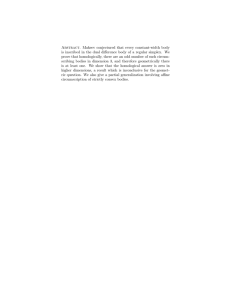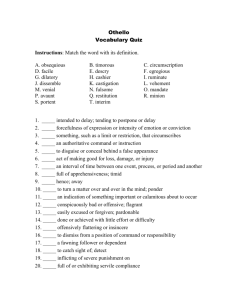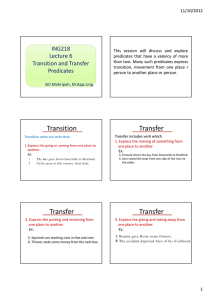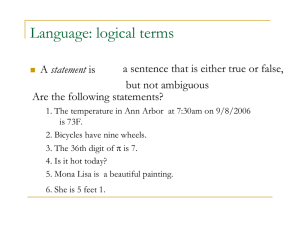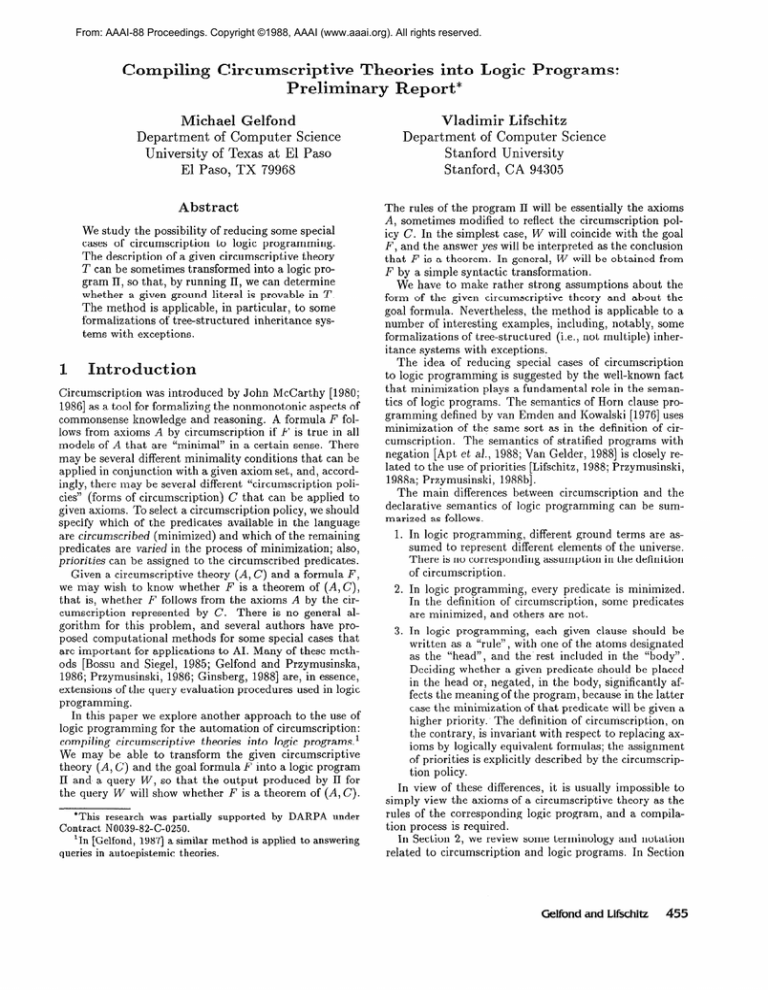
From: AAAI-88 Proceedings. Copyright ©1988, AAAI (www.aaai.org). All rights reserved.
Compiling
Circumscriptive
Theories into Logic Programs:
Preliminary
Report*
Michael Gelfond
Department of Computer Science
University of Texas at El Paso
El Paso, TX 79968
Abstract
We study the possibility
of reducing some special
cases of circumscription
to logic programming.
The description
of a given circumscriptive
theory
T can be sometimes
transformed
into a logic program II, so that, by running II, we can determine
whether
a given ground literal is provable in T.
The method is applicable,
in particular,
to some
formalizations
of tree-structured
inheritance
systems with exceptions.
I
ntroduction
Circumscription
was introduced
by John McCarthy
[1980;
19861 as a tool for formalizing
the nonmonotonic
aspects of
commonsense
knowledge and reasoning.
A formula F follows from axioms A by circumscription
if F is true in all
models of A that are “minimal”
in a certain sense. There
may be several different minimality
conditions
that can be
applied in conjunction
with a given axiom set, and, accordingly, there may be several different “circumscription
policies” (forms of circumscription)
C that can be applied to
given axioms. To select a circumscription
policy, we should
specify which of the predicates
available
in the language
are circumscribed
(minimized)
and which of the remaining
predicates
are varied in the process of minimization;
also,
priorities
can be assigned to the circumscribed
predicates.
Given a circumscriptive
theory (A, C) and a formula F,
we may wish to know whether
F is a theorem
of (A, C),
that is, whether
F follows from the axioms A by the circumscription
represented
by C. There is no general algorithm
for this problem,
and several authors
have proposed computational
methods for some special cases that
are important
for applications
to AI. Many of these methods [Bossu and Siegel,
1985; Gelfond and Przymusinska,
1986; Przymusinski,
1986; Ginsberg,
19881 are, in essence,
extensions
of the query evaluation
procedures
used in logic
programming.
In this paper we explore another approach
to the use of
logic programming
for the automation
of circumscription:
compiling
circumscriptive
theories in to logic programs.’
We may be able to transform
the given circumscriptive
theory (A, C) and the goal formula F into a logic program
II and a query W, so that the output produced
by II for
the query W will show whether F is a theorem of (A, C).
*This research was partially supported by DARPA under
Contract N0039-82-C-0250.
‘In [Gelfond, 19871 a similar method is applied to answering
queries in autoepistemic
theories.
Vladimir Lifschitz
Department of Computer Science
Stanford University
Stanford, CA 94305
The rules of the program II will be essentially
the axioms
A, sometimes
modified to reflect the circumscription
policy C. In the simplest
case, W will coincide with the goal
F, and the answer yes will be interpreted
as the conclusion
that F is a theorem.
In general, W will be obtained from
F by a simple syntactic
transformation.
We have to make rather strong assumptions
about the
form of the given circumscriptive
theory and about the
goal formula.
Nevertheless,
the method is applicable
to a
number of interesting
examples,
including,
notably, some
formalizations
of tree-structured
(i.e., not multiple)
inheritance systems with exceptions.
The idea of reducing
special
cases of circumscription
to logic programming
is suggested
by the well-known fact
that minimization
plays a fundamental
role in the semantics of logic programs.
The semantics
of Horn clause programming
defined by van Emden and Kowalski [1976] uses
minimization
of the same sort as in the definition
of circumscription.
The semantics
of stratified
programs
with
negation
[Apt et al., 1988; Van Gelder, 1988) is closely related to the use of priorities
[Lifschitz,
1988; Przymusinski,
1988a; Przymusinski,
1988b].
The main differences
between circumscription
and the
declarative
semantics
of logic programming
can be summarized as follows.
1. In logic programming,
different ground terms are assumed to represent
different elements of the universe.
There is no corresponding
assumption
in the definition
of circumscription.
2. In logic programming,
every predicate
is minimized.
In the definition
of circumscription,
some predicates
are minimized,
and others are not.
3. In logic programming,
each given clause should be
written as a “rule”, with one of the atoms designated
as the “head”, and the rest included in the “body”.
Deciding
whether a given predicate
should be placed
in the head or, negated, in the body, significantly
affects the meaning of the program, because in the latter
case the minimization
of that predicate will be given a
higher priority.
The definition
of circumscription,
on
the contra.ry, is invariant with respect to replacing axioms by logically equivalent
formulas; the assignment
of priorities
is explicitly
described by the circumscription policy.
In view of these differences,
it is usually impossible
to
simply view the axioms of a circumscriptive
theory as the
rules of the corresponding
logic program,
and a compilation process is required.
In Section 2, we review some terminology
and notation
related to circumscription
and logic programs.
In Section
Gelfond and Likhitz
455
3, a series of examples
is given in which circumscriptive
theories
are translated
into logic programs.
In Section
4
we state a theorem
that demonstrates
the correctness
of
the method used in these examples.
The full paper will
contain the proof of the theorem and some extensions.
2
Terminology
and Notation
We start
with a fixed first-order
language
with a finite
number of object,
function
and predicate
constants.
In
this preliminary
report we assume that there are no functions in the language,
so that its only ground terms are
object
constants
Cl, C2, , . . . In this case we call the formulas Ci $1 Cj (i < j) the uniqueness
of names axioms for
this language.
An atom is an atomic formula not containing
equality.
A literal is an atom (positive
literal)
or a negated
atom
(negative
literal).
A clause is a disjunction
of literals.
A
clause is negative
if each of its literals
is negative,
and
definite if it has exactly
one positive
literal.
A rule is a
formula of the form
L1 A...
AL,>A,
where L1,...,Lnz
(m 10)
are literals (they form the body
of the rule), and A is an atom (the head). A clause that has
I, positive literals can be written as a rule in Ic essentially
different ways, because any of the i%positive literals can be
placed in the head. In particular,
a negative clause cannot
be written
as a rule, and a definite clause corresponds
to
a. single rule.
A program is a finite set of rules. We identify a program
with the conjunction
of its rules. The definition of a predicate P in a program
II is the subset of II consisting
of all
rules that contain P in the head. A stratification2
of II is
a partition
of its predicates
into disjoint parts
Pl;.
. .; Pk
such that, for every predicate
P from Pi (1 5 ?: < L), (a)
all predicates
that occur in the definition
of P belong to
PI,...
, Pi, and (b) all predicates
that occur in the definiIt is convenient
tion of P under 1 belong to PI, . . . , Pi-l.
to allow some of the parts Pi to be empty. A program is
stratified if it has a stratification.
If A is a sentence,
and P, 2 are disjoint lists of predicates, then Circum(A;
P; 2) stands for the result of circumscribing
the predicates
in P relative
to A, with the
predicates
in 2 allowed to va.ry [Lifschitz,
19851. If P is
broken into parts P’, . . . , P”, then the circumscription
assigning a higher priority to the members of Pi than to the
members of Pj for i < j is denoted by
Circum(A;
P1 > . . . > P”; 2).
The last argument
2 will be omitted
if it is empty.
Notice that we use semicolons
to separate
the arguments
of
Circum from each other, whereas commas are used to separate predicates
inside each of the lists P’, . . . , Pk, 2.
If II is a stratified
program without functions
then, according to [Przymusinski,
1988b],
its semantics
can be
characterized
as follows:
a sentence
F in the language
of
“This is essentially
except tha.t we stratify
456
the definition from [Apt et al., 19881,
predicates, rather than rules.
Knowledge Representation
n is true relative
of names axioms,
t,o II if, in the presence
it follows
Circum($TI;
from
of the uniqueness
the circumscription
P1 > . . . > P”),
where \;, denotes
universal
closure,
and PI; . . . ; P” is a
stratification
of II. Denote this circumscription
by II’.
Given a stratified
program II and a ground atom W, a
logic programming
interpreter
is supposed to answer yes if
W is true relative to II, and no if 1W is true. Accordingly,
we define:
Ans(II,
ifUAII’bW;
ifUAII’+=W;
otherwise,
yes,
no,
{ undefined,
W) =
where U is the conjunction
of the uniqueness
of names axioms.
The third case corresponds
to the situation
when
neither W nor lT/v follows from the circumscription.
According to [Przymusinski,
198Sb], this is only possible for
floundered
queries.
This semantics
differs from the iterated
fixed point semantics
[Apt et al., 19S8; Van Gelder,
19SS] in that the
latter takes into account Herbrand
models only.
If W is a. ground atom whose predicate
does not belong
to the language of II then we set Ans(II, T/v) = no.
3
Examples
Example 1. Consider
the circumscriptive
theory
with the
John
# Jim,
(1)
a.xioms:
John
# Jack,
f ather(
# Jim,
John,
father(Jack,
father(x,
y) A father(y,
Jack
Jack),
(2)
Jim),
z) 3 grandfathe?(x,
(3)
z),
(4)
with both predicates
fatlzer
and g~ancl~athev
minimized.
How can we use logic programming
to determine
whether
a given ground literal in the language of this t,heory is a
theorem?
Consider
the logic program
II whose rules are
(a), (3) and (4). If the goal formula is a ground a.tom TV
then W follows from axioms (l)-(4)
by circumscription
iff Ans(II, TW) = yes.
If the goal formula, is a negated
with the
ground atom, then let T/lr be the goal formula
lT/lr
follows from the axioms by
negation
sign removed;
circumscription
iff Ans(II, W) = no.
The translation
process used in Example
1 is extremely
simple:
II is obtained
from the axiom set A by dropping
from the goal formula
some axioms,
and W is obtained
by dropping the negation sign, if there was one. The main
reason why translating
was so easy is that the circumscription policy in this example is the standard
circumscription
policy of Horn clause logic programming
- minimizing
all
predicates.
Remark 1. It is essential that the uniqueness of na.mes axioms (1) were initially
included in the axiom set. Without
them, it would be impossible
to prove any negated ground
atom, and such formulas as fathe?a( John, John)
would be
undecidable.3
At the same time, it is essential
that these
3To see why, consider a model of axioms (2)-(4)
in which
the universe is a singleton. The extents of all predicates in this
model are minimal.
axioms were deleted in the process of compilation:
tactically,
they are not rules and cannot be included
program.
Remark 2. If axiom
7father(x,
(4) were written
y) V 7father(y,
Synin a
bird(x)
as a clause
z) V grandfather(z,
z),
(4’)
then an additional
step would be required:
replacing
this
clause by the corresponding
rule (4). Notice that clause
(4’) is definite, so that it can be written as a rule in only
one way.
In applications
to formalizing
commonsense
reasoning,
circumscription
is often used to minimize
“abnormality”
contains
[McCarthy,
19861.
I n such cases, the language
one or more abnormality
predicates
ub, ubl, ub2, . . . . These
predicates express that their arguments
are exceptional
relative to some “default principles”.
Example 2. The axioms
Tweety
# Opus,
bird(x)
# Joe,
A hub
Opus
# Joe,
> flies(x),
(6)
y) ,
(7)
bird( Opus),
(8)
ub(Opus).
(9)
1. If Ans(II, P(c)) = yes tl ien the given circumscription
implies P(c).
In this wa.y we conclude
that the circumscription
implies
bird(Opus),
fZies(Tweety).
2. If An@,
P(c))
= no and P is one of the circumscribed predicates
ub and bird, then the circumscription implies lP(c).
I n tl iis wa.y we get the conclusions
lub(Tweety),
Gird(
Joe).
3. If Ans(II,P(c))
= no and P is the varied predicate
flies,
then P(c) is undecidable:
The circumscription
implies neither P(c) nor lP(c).
We conclude that the
and fZies(Joe)
ca.n be neither
formulas fZies(Opus)
proved nor refuted on the basis of the given axioms
eveii using circumscription.
Remark
stratified.
and flies
3. The
program
constructed
in Example
2 is
For instance,
we can place bird and ab in P’,
in P2.
Remark 4. If axiom
Third(x)
3. Replace axioms
by the axioms
(6) were written
V cd(z)
V fZies(
as a cla.use
x),
*Another reasonable circumscription
policy is to leave bird
fixed. Unfortunately,
onr method is not applicable to circumscriptions witch fixed predicates.
> ub(x).
(6’)
(8) and (9) in the previous
penguin(Opus),
penguin(x)
(5)
Axiom (6) ex p resses that normally birds can fly. The predflies is varied.4
icates czb and bird are minimized;
We compile the given axiom set into a logic progra.m II in
the same way as above, i.e., simply delete the uniqueness
of names axioms (5).
The answer given by a logic programming
system to a query P(c), where P is one of the
predicates
ub, bz’~*cZ
and flies,
and c is one of the constants
Tweety,
Opu.s, a.nd Joe, is interpreted
a.s follows:
-ub( Joe),
Example
example
penguin(x)
Tweety
bird(Tweety),
A lfZies(x)
two ways of writing
The second possibility
would lead to a stratified
program
also (place bird and flies
in P1 and ub in P2).
But that
program
would not be satisfactory
for our purposes:
It
answers no to the query fZies(Tweety),
even though this
query follows from the axioms by circumscription.
We will
see in Section 4 that the main result justifying
the correctness of our method distinguishes
between (6) and (6’) by
demanding
that, in the absence of priorities,
the circumscribed predicates
belong to the first stratum
PI.
are:
bird(Tweet
ub(Opus),
between
then we would have a
it as a rule: (6) and
(10)
II bird(x),
(11)
3 Iflies(
(12)
lfZies( Joe).
(13)
Thus the new axiom set is (5)-(
7)) ( lo)---( 13). We minimize ub, bird and penguin,
and vary flies. The transformation used in Exa.mples 1 and 2 (dropping the uniqueness
of names axioms) is not sufficient in this case for producing a program, beca.use some of the remaining
axioms, (12)
and (13)) are not rules. In fact, (13) is a. negative clause,
and (12)) written as a clause, is negative a.lso, so l,hat it is
impossible
to write either as a rule. Some addit,ional work
is needed.
The key observation
is that the remaining
formulas (6))
if we replace
all
(7), (lo)-(
13) will b ecome a program
occurrences
of TfZies
by a new preclicate,”
rules of this program are (6)) (7), (lo), (ll),
penguin(x)
flies.
The
(12’)
3 flies(x)
and
fZies( Joe).
(13’)
This program,
however, is not satisfactory
for our purpose, because it treats flies and flies as unrelat,ed predThe information
that they represent
each other’s
icates.
negation
is lost here.
This can be fixed in the following
way. Let us go back to the axiom set (6)) (7)) (lo)-(13)
and find all pairs of axioms that, writ.ten as clauses,
can
be resolved upon fdies. There are 2 such pairs: (6)) (12)
and (6)) (13). Th e resolvent of the first pair is the definite
clause
4kd(x)
V U/I(X) V lpenguin(x);
written
as a rule,
it becomes6
bird(x)
The
resolvent
A penguin
of the second
4ird(
written
as a rule,
Joe)
(xc> > ub( x).
pair is the definite
(14)
clause
V ub( Joe);
it becomes
bird( Joe)
> ub( Joe).
(15)
5Similar transformations
were used by several authors, beginning with Meltzer [1966].
61n view of asiom (ll), the literal bird(z)
in t,his rule ca.n be
dropped. We will ignore “optimization?
of this kind.
Gelfond and Lifschitz
457
We add the resolvents
obtained
(14),
by introducing
bird(x)
(15) to the program
flies.
The
A -d(x)
result
that
was
is the program:
(7)
penguin(Opus),
(10)
> bird(x),
(11)
penguin(x)
3 fZies(x),
(12’)
fZies(Joe),
bird( Joe)
(15)
If the goal literal F does not have the form TfZies(c)
then the program is used for resolving F in the same way
as before.
We conclude
that these facts follow from the
axioms by circumscription:
xb(Tweety),
bird(Tweet
ab(Opus),
lab(Joe),
y), bird(Opus),
lpenguin(Tweety),
+ird(
penguin(Opus),
fZies(Tweet
Ipenguin(Joe),
y).
About the formulas
fZies(Opus)
and fZies(Joe)
we conclude that they do not follow from the axioms by circumthen we look at the answer
scription.
If W is lfZies(c)
to the query flies(c).
If the answer is yes then W follows
from the axioms by circumscription;
if no then it does not.
In our example,
we get lfZies(Opus)
and lfZies(Joe).
Finally, we will show that prioritized
circumscription
can
be sometimes
compiled into a logic program in essentially
the same way.
Example 4. Let us make axiom (12) in Example
and replace
A labl(x)
> Iflies
(normally,
penguins
cannot fly).
The new abnormality
predicate
ubl will be circumscribed
at a higher priority
than ab, in accordance
with the familiar
principle
that
more specific information
in an inheritance
system should
be given a higher priority.
Thus we give priority 1 to minimizing ubl, Bird and penguin,
and priority 2 to minimizing
ab; as before, flies
is varied.
Replacing
lflies
by flies
gives
penguin(x)
A l&l(x)
> flies(x).
Pb)
The first of the two resolvents
computed
compilation
will get an additional
term:
4&-d(x)
V c&(x) V lpenguin(x)
in the process
V &l(x).
of
(16)
This clause has 2 positive
literals,
ah(x) and &l(x),
that we have to decide which of them should be placed
the head. We choose the form
bird(x)
A penguin(x)
A ~~bl(x)
> d(x),
so
in
W-d
because the given circumscription
policy assigns to ubl a
higher priority
than to u.b. Generally,
we will require that
the resulting program have a stratification
with the higher
priority predicates
placed in the lower strata. This requirement determines
how the assignment
of priorities
affects
Knowledge Representation
(7)
r> bird(x),
A -&l(x)
(11)
> flies(x),
(13’)
A l&l(x)
A penguin(x)
tw
> ub(x),
II ub( Joe).
WJ)
(15)
Its answers are interpreted
in the same way as in Exa.mple 3. If the predicate
in the goal literal is ub, bird,
penguin
or flies, then the result of computation
is the
same as before. To each query of the form &l(c)
the program answers no, which shows that all these formulas can
be refuted in the given circumscriptive
theory.
Main
Theorem
Let A be (the conjunction
of) a set of clauses without function symbols.
These clauses, along with the uniqueness
of
names axioms,
will constitute
the axiom set of the circumscriptive
theory that we want to compile into a logic
The circumscription
policy of the theory will
program.
be determined
by k disjoint lists of predicates
P’, . . . , Pk’
(k 1 1) occurring
in A. These predicates
will be minimized:
Those included
in P1 with the highest
priority,
those in P’ with the lowest.
Let 2 be the list of predicates 21, . . . , 21 that occur in A but are not included in
, P”. These predicates
will be allowed to vary. SymPl,...
bolically,
the circumscription
under consideration
is
3 weaker
(120)
(6)
(10)
bird( Joe)
Circum(‘dA
it by
pengu.in(x)
458
bird(x)
is the
> flies(x),
fZies(Joe),
4
Joe),
of compilation
penguin(Opus),
penguin(x)
(14)
3 ab( Joe).
result
bird(Tweety),
penguin(x)
(13’)
>~ub(x),
The
A Y&(X)
(6)
bird(Tweety),
A penguin(x)
of compilation.
bird(x)
> flies(x),
penguin(x)
bird(x)
the result
program
A U; P1 > . . . > P’; Z),
where U is the conjunction
of the uniqueness
of names
axioms.
We will denote this formula by Circum.
We assume that every clause in A contains at most one
literal whose predicate
symbol belongs to 2.
We have seen that the process of compilation
may include the replacement
of some negated predicates
by new
predicate
symbols,
and also deriving new axioms by resolution.
To describe
these processes
in the general form,
assume that for each i (,l 5 i 5 Z) a new predicate
zi is
selected_, of the same arity as Zi. The list of new predBy Replace(A)
icates 21, . . . , zl will be denoted by z.
we denote the result of replacing
Let Resolve(A)
be (th e conjunction
that can be obtained
by resolving
A upon an atom whose predicate
Since every clause in A contains at
predicate
belongs to 2, the formula
contain predicates
from 2.
Theorem
1.
Let II
Replace(A)
U Resolve(A)
so that the partition
Pl;
is a stratification
whose predicate
each 1Zi in A by zi.
of) the set of clauses
a pair of clauses from
symbol belongs
to 2.
most one literal whose
Resolve(A)
does not
be a program
obtained
from
by writing each clause as a rule,
. . . . P”;
2,-z
of II.
Then, for any ground
symbol occurs in A,
(17)
atom
W
j= W
1. Circum
2. If the predicate
then
Circum
3. If the predicate
Circum
/= 1W
iff
Ans(II,
symbol
b TW
symbol
iff
W) = yes;
of W belongs
iff
Ans(lI,
of W belongs
to P’, . . . , P”,
W) = no;
to 2,
Ans(II,RepZuce(~W))
then
= yes.
It is easy to see that the conclusions
made in Examples
l-4
above can be justified
on the basis of Theorem
1. In
Example 2, the predicate flies does not belong to the language of the program obtained as the result of compilation;
this fact justifies our conclusion
that no literal of the form
lflies(c)
is a theorem.
Remark 5. There is no guarantee,
of course, that each
U ResoZve(A)
can be written
as a
clause in Replace(A)
rule stratified
by (17).
But there is a simple algorithm
that transforms
a given clause X into a rule stratified
by
(17) or determines
that this is impossible.
If X is negative, then the task is impossible.
Otherwise,
find the last
among the groups (17) that contain a predicate
occurring
in X positively.
If X has only one positive literal whose
predicate
is in that group, then make this literal the head
of the rule. Otherwise
the task is impossible.
An important
class of examples
in which some clauses
cannot be stratified by (17) IS
* g iven by multiple inheritance
systems.
Example 5. The system formalized in Example 4 will become a multiple inheritance
system if we disregard the fact
that penguins
are a subclass
of birds, and treat penguin
and bird as two partially overlapping
classes. Formally, we
consider the circumscriptive
theory with the axioms (5)assigned
(7), (lo), (120) (13) and with the same priority
to the minimized
predicates
ub, ubl.
Now both positive
predicates
in clause (16), obtained by resolving (6) against
(120), belong to P i. Hence there is no way to write that
clause as a rule stratified
by (17).
Remark
6. If A consists
of n clauses, then RepZuce(A)
consists
of n clauses too, and the number of clauses in
Resolve(A)
is at most (n2 - n)/2. Hence the number of
rules in II is at most (n2 + n)/2.
Acknowledgments
We are grateful
to Krzysztof
Apt,
John McCarthy,
Halina Przymusinska
musinski for useful discussions.
Matthew
Ginsberg,
and Teodor Przy-
eferences
[Apt et al., 19SS] Krzysztof
R. Apt, Howard A. Blair, and
Adrian Walker. Towards a theory of declarative
knowledge. In J. Minker
(ed.),
Foundations
of Deductive
Databases
and Logic Programming,
pages 89-148. Morgan Kaufmann
Publishers,
Los Altos, CA, 1988.
[van Emden and Kowalski,
19761 Maarten
H. van Emden
and Robert
A. Kowalski.
The
semantics
of prediJournal ACM,
cate logic as a programming
language,
23(4):733-742,
1976.
[Gelfond, 19871 Michael
Gelfond.
On stratified
autoepistemic theories.
In Proceedings
AAAI-87, 1, pages 207211. Morgan
Kaufmann
Publishers,
Los Altos,
CA,
1987.
[Gelfond and Przymusinska,
19SS] Michael
Gelfond
and
Halina Przymusinska.
Negation
as failure:
Careful cloItitelligence
30(3):273-288,
sure procedure.
Artificial
1986.
[Ginsberg,
theorem
ings.
19881 Matthew
Ginsberg.
prover:
preliminary
report.
A circumscriptive
In these Proceed-
[Lifschitz,
19851 Vl a d imir Lifschitz.
Computing
circumscription.
In Proceedings
IJCAI-85,
1, pages 121-127.
Morgan Kaufmann
Publishers,
Los Altos, CA, 19S5.
[Lifschitz,
19881 Vl a d imir Lifschitz.
On the declarative
semantics of logic programs
with negation.
In J. Minker
(ed.), Foundations
of Deductive
Databases
and Logic
Programming,
pages 177-192.
Morgan Kaufmann
Publishers, Los Altos, CA, 1958.
[McCarthy,
19801 John
form of non-monotonic
13(1,2):27-39,
1980.
McCarthy.
reasoning.
Circumscription
a
Artificial Intelligence
[McCarthy,
19S6] John McCarthy.
Applications
of circumscription
to formalizing
commonsense
knowledge,
Artificial Intelligence
28(1):89-118,
1986.
[Meltzer,
19661 Bernard
Meltzer.
Theorem
proving
for
computers:
some results on resolution
and renaming.
Comput. Journal, 8:341-343,
1966.
[Przymusinski,
19861 Teodor
Przymusinski,
Query
answering in circumscriptive
and closed-world
theories.
In
Proceedings
AAAI-86,
1, pages 186-190.
Morgan Kaufmann Publishers,
Los Altos, CA, 1986.
[Przymusinski,
1988a] Teodor
Przymusinski.
On the declarative
semantics
of deductive
databases
and logic
of Deducprograms.
In J. Minker
(ed.), Foundations
tive Databases and Logic Programming,
pages 193-216.
Morgan Kaufmann
Publishers,
Los Altos, CA, 1988.
[Przymusinski,
1988131 Teodor
Przymusinski.
On the declarative and procedural
semantics
of logic programs.
Preprint,
University
of Texas at El Paso, 1988.
[Van Gelder, 19881 Allen Van Gelder. Negation
as failure
using tight derivations
for general logic programs.
In J.
Minker (ed.), Foundations
of Deductive
Databases
and
Logic Programming,
pages 149-176.
Morgan Kaufmann
Publishers,
Los Altos, CA, 1988.
[Bossu and Siegel, 19851 G enevieve Bossu and Pierre Siegel. Saturation,
nonmonotonic
reasoning and the closedworld assumption.
Artificial
Intelligence,
25( 1):13-63,
1985.
Gelfond and Lifschitz
459

